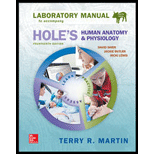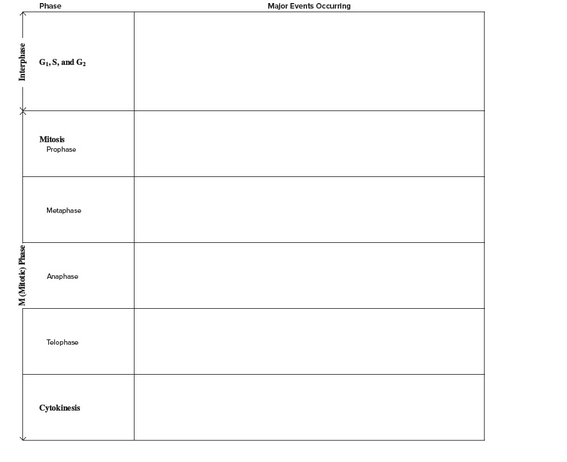
Concept explainers
Complete the table by listing the major events of each phase in the box. 
To write:
The major events occurring in different phases of a cell cycle.
Introduction:
A cell cycle is a sequence of events that involves growth and division of a cell in two daughter cells. The major stages of a cell cycle are mitotic phase,interphase and G0. The interphase includes G1, G2 and S phase whereas the mitotic phase includes prophase, metaphase, anaphase, telophase and cytokinesis.
Answer to Problem 1.1A
| Phase | Major events occurring | |
| Interphase | ||
| G1 | The cell grows physically. | |
| S | The DNA content duplicates in this phase. | |
| G2 | The cell prepares other cellular components required for mitosis. | |
| Mitotic phase | ||
| Mitosis | Prophase | 1. Chromosomes starts to condense at this stage. 2. Spindle fibers starts forming from two opposite poles 3. Nuclear envelope starts breaking. 4. Nucleolus starts to disappear. |
| Metaphase | 1. Sister chromatids attach to the spindle fibers through kinetochore. 2. Chromosomes line up at metaphase plate. | |
| Anaphase | 1. Spindle fibers that do not bind to the kinetochore, lengthens and elongates the cell. 2. Pulling of sister chromatids at opposite poles. | |
| Telophase | 1. Chromosomes that moved to opposite poles starts to decondense. 2. Nuclear envelope starts forming again around the chromosomes. 3. Spindle fibers starts to break down. | |
| Cytokinesis | Cytoplasm divides in this phase. a) In animal cell, the daughter cells are separated by formation of cleavage furrow. b) In plant cell, the daughter cells are separated by formation of cell plate. |
Explanation of Solution
Interphase is the growth and preparatory phase of a cell to undergo division. A cell is metabolically active during the G1 phase. The cell builds different molecular blocks, copies organelles and physically becomes larger.
Once the G1 phase ends, the cell enters the S phase. Replication of DNA occurs during this phase. The two copies formed are delivered to each daughter cells formed after cell division.
The G2 phase follows the S phase. It is also known as the second gap phase during which the cells prepare themselves to undergo the mitotic phase by synthesizing additional cellular components.
The interphase is succeeded by the mitotic phase. A cell undergoes Karyokinesis (mitosis) and cytokinesis during this phase. The mitosis includes the following events:
Prophase: The nuclear envelope starts to disintegrate to expose the condensed chromosomes in the cytoplasm. Spindle fibers start to emerge from the centrioles and bind with the sister chromatids at a site known as kinetochore. Nucleolus also disappears during the prophase.
Metaphase: The sister chromatids bound to the spindle fibers (originating from opposite poles) via kinetochore, are arranged at a central metaphase plate.
Anaphase: Cohesin protein that is responsible for binding the sister chromatids together, breaks down and the chromatids move to the opposite pole by the pull of attached spindle fibers. Spindle fibers that are not attached to the kinetochore, lengthens and elongates the cell.
Telophase: It is the final stage of mitosis that includes the formation of the nuclear envelope around the separated chromatids at opposite poles. The chromatids start to decondense and spindle fibers also break down.
The karyokinesis is followed by the cytokinesis that includes division of cytoplasm and the cell into two halves, each having the nucleus, cytoplasm and some organelles. In animal cells, cell furrow divides the two daughter cells whereas cell plate divides the two daughter cells in a plant cell.
Want to see more full solutions like this?
Chapter 7 Solutions
Laboratory Manual for Holes Human Anatomy & Physiology Fetal Pig Version
Additional Science Textbook Solutions
Biological Science (6th Edition)
College Physics: A Strategic Approach (3rd Edition)
Organic Chemistry
SEELEY'S ANATOMY+PHYSIOLOGY
Biology: Life on Earth with Physiology (11th Edition)
- Pleiotropic genes are genes that (blank) Cause a swapping of organs/structures, are the result of duplicated sets of chromosomes, never produce protein products, and have more than one purpose/functionarrow_forwardA loss of function mutation in Pitx1 enhancers can cause (blank) Removal of Pitx1 exons and growth of ectopic hindlimbs, growth of extra ectopic forelimbs, loss of forelimb specification and development, and loss of hindlimb specification and developmentarrow_forwardHox1a most likely contributes to (blank) patterning in the developing embryo? Ventral, posterior, limb or anteriorarrow_forward
- Select all of the following that can help establish Hox gene expression boundaries (things that affect Hox and not things that Hox affects). Retinoic acid, anterior/posterior axis, fibroblast growth factors, vagal neural crest, and enhancersarrow_forwardEctopic expression of Hox often results in (blank) phenotypes. (Blank) transformations are characterized by the replacement of one body part/structure with another. Hoxeotic, homealoneotic, joexotic, or homeoticarrow_forwardWhat's the difference when drawing omega-6 and omega-3?arrow_forward
- . Consider a base substitution mutation that occurred in a DNA sequence that resulted in a change in the encoded protein from the amino acid glutamic acid to aspartic acid. Normally the glutamic acid amino acid is located on the outside of the soluble protein but not near an active site. O-H¨ A. What type of mutation occurred? O-H B. What 2 types of chemical bonds are found in the R-groups of each amino acid? The R groups are shaded. CH2 CH2 CH2 H2N-C-COOH H2N-C-COOH 1 H Glutamic acid H Aspartic acid C. What 2 types of bonds could each R-group of each of these amino acids form with other molecules? D. Consider the chemical properties of the two amino acids and the location of the amino acid in the protein. Explain what effect this mutation will have on this protein's function and why.arrow_forwardengineered constructs that consist of hollow fibers are acting as synthetic capillaries, around which cells have been loaded. The cellular space around a single fiber can be modeled as if it were a Krogh tissue cylinder. Each fiber has an outside “capillary” radius of 100 µm and the “tissue” radius can be taken as 200 µm. The following values apply to the device:R0 = 20 µM/secaO2 = 1.35 µM/mmHgDO2,T = 1.67 x 10-5 cm2/secPO2,m = 4 x 10-3 cm/secInstead of blood inside the fibers, the oxygen transport and tissue consumption are being investigated by usingan aqueous solution saturated with pure oxygen. As a result, there is no mass transfer resistance in the synthetic“capillary”, only that due to the membrane itself. Rather than accounting for pO2 variations along the length ofthe fiber, use an average value in the “capillary” of 130 mmHg.Is the tissue fully oxygenated?arrow_forwardMolecular Biology Please help with question. thank you You are studying the expression of the lac operon. You have isolated mutants as described below. In the presence of glucose, explain/describe what would happen, for each mutant, to the expression of the lac operon when you add lactose AND what would happen when the bacteria has used up all of the lactose (if the mutant is able to use lactose).5. Mutations in the lac operator that strengthen the binding of the lac repressor 200 fold 6. Mutations in the promoter that prevent binding of RNA polymerase 7. Mutations in CRP/CAP protein that prevent binding of cAMP8. Mutations in sigma factor that prevent binding of sigma to core RNA polymerasearrow_forward
- Molecular Biology Please help and there is an attached image. Thank you. A bacteria has a gene whose protein/enzyme product is involved with the synthesis of a lipid necessary for the synthesis of the cell membrane. Expression of this gene requires the binding of a protein (called ACT) to a control sequence (called INC) next to the promoter. A. Is the expression/regulation of this gene an example of induction or repression?Please explain:B. Is this expression/regulation an example of positive or negative control?C. When the lipid is supplied in the media, the expression of the enzyme is turned off.Describe one likely mechanism for how this “turn off” is accomplished.arrow_forwardMolecular Biology Please help. Thank you. Discuss/define the following:(a) poly A polymerase (b) trans-splicing (c) operonarrow_forwardMolecular Biology Please help with question. Thank you in advance. Discuss, compare and contrast the structure of promoters inprokaryotes and eukaryotes.arrow_forward
 Biology Today and Tomorrow without Physiology (Mi...BiologyISBN:9781305117396Author:Cecie Starr, Christine Evers, Lisa StarrPublisher:Cengage LearningHealth Safety And Nutrition F/Young ChildHealth & NutritionISBN:9781305144767Author:MAROTZPublisher:Cengage
Biology Today and Tomorrow without Physiology (Mi...BiologyISBN:9781305117396Author:Cecie Starr, Christine Evers, Lisa StarrPublisher:Cengage LearningHealth Safety And Nutrition F/Young ChildHealth & NutritionISBN:9781305144767Author:MAROTZPublisher:Cengage- Essentials Health Info Management Principles/Prac...Health & NutritionISBN:9780357191651Author:BowiePublisher:Cengage





